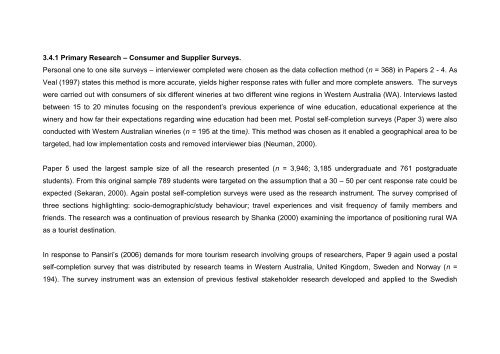The Role of Niche Tourism Products in Destination - Repository ...
The Role of Niche Tourism Products in Destination - Repository ...
The Role of Niche Tourism Products in Destination - Repository ...
You also want an ePaper? Increase the reach of your titles
YUMPU automatically turns print PDFs into web optimized ePapers that Google loves.
3.4.1 Primary Research – Consumer and Supplier Surveys.<br />
Personal one to one site surveys – <strong>in</strong>terviewer completed were chosen as the data collection method (n = 368) <strong>in</strong> Papers 2 - 4. As<br />
Veal (1997) states this method is more accurate, yields higher response rates with fuller and more complete answers. <strong>The</strong> surveys<br />
were carried out with consumers <strong>of</strong> six different w<strong>in</strong>eries at two different w<strong>in</strong>e regions <strong>in</strong> Western Australia (WA). Interviews lasted<br />
between 15 to 20 m<strong>in</strong>utes focus<strong>in</strong>g on the respondent’s previous experience <strong>of</strong> w<strong>in</strong>e education, educational experience at the<br />
w<strong>in</strong>ery and how far their expectations regard<strong>in</strong>g w<strong>in</strong>e education had been met. Postal self-completion surveys (Paper 3) were also<br />
conducted with Western Australian w<strong>in</strong>eries (n = 195 at the time). This method was chosen as it enabled a geographical area to be<br />
targeted, had low implementation costs and removed <strong>in</strong>terviewer bias (Neuman, 2000).<br />
Paper 5 used the largest sample size <strong>of</strong> all the research presented (n = 3,946; 3,185 undergraduate and 761 postgraduate<br />
students). From this orig<strong>in</strong>al sample 789 students were targeted on the assumption that a 30 – 50 per cent response rate could be<br />
expected (Sekaran, 2000). Aga<strong>in</strong> postal self-completion surveys were used as the research <strong>in</strong>strument. <strong>The</strong> survey comprised <strong>of</strong><br />
three sections highlight<strong>in</strong>g: socio-demographic/study behaviour; travel experiences and visit frequency <strong>of</strong> family members and<br />
friends. <strong>The</strong> research was a cont<strong>in</strong>uation <strong>of</strong> previous research by Shanka (2000) exam<strong>in</strong><strong>in</strong>g the importance <strong>of</strong> position<strong>in</strong>g rural WA<br />
as a tourist dest<strong>in</strong>ation.<br />
In response to Pansiri’s (2006) demands for more tourism research <strong>in</strong>volv<strong>in</strong>g groups <strong>of</strong> researchers, Paper 9 aga<strong>in</strong> used a postal<br />
self-completion survey that was distributed by research teams <strong>in</strong> Western Australia, United K<strong>in</strong>gdom, Sweden and Norway (n =<br />
194). <strong>The</strong> survey <strong>in</strong>strument was an extension <strong>of</strong> previous festival stakeholder research developed and applied to the Swedish
















